Burketown is a very small town which would be considered rural by all standard definitions.
ASN00029004 -17.7425 139.5475 5.5 BURKETOWN POST OFFICE
Maximum temperatures there show no net warming since the 1890’s.
But minimum temperatures recorded at Burketown have warmed about 1C, almost all of which occurred during a few years around 1980.
At first glance, Burketown looks very rural.
But closer inspection shows that the thermometer is located near a large area of asphalt.
No too surprising that nighttime temperatures rose, after the roads were paved.

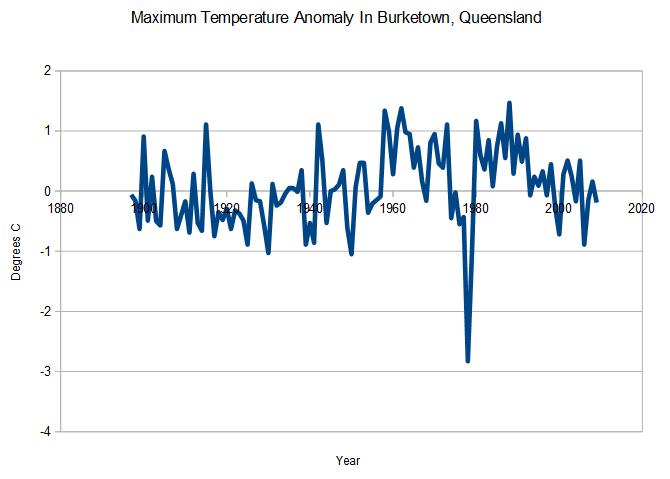
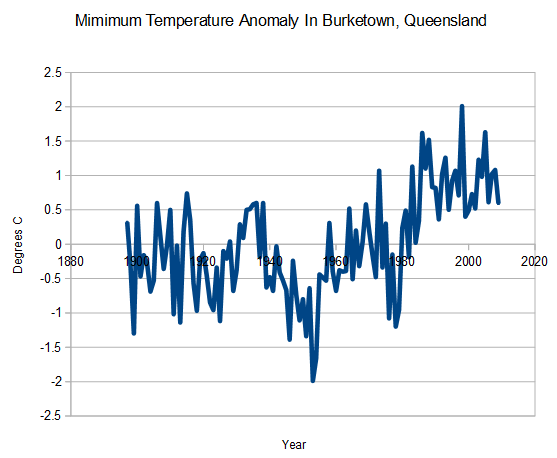
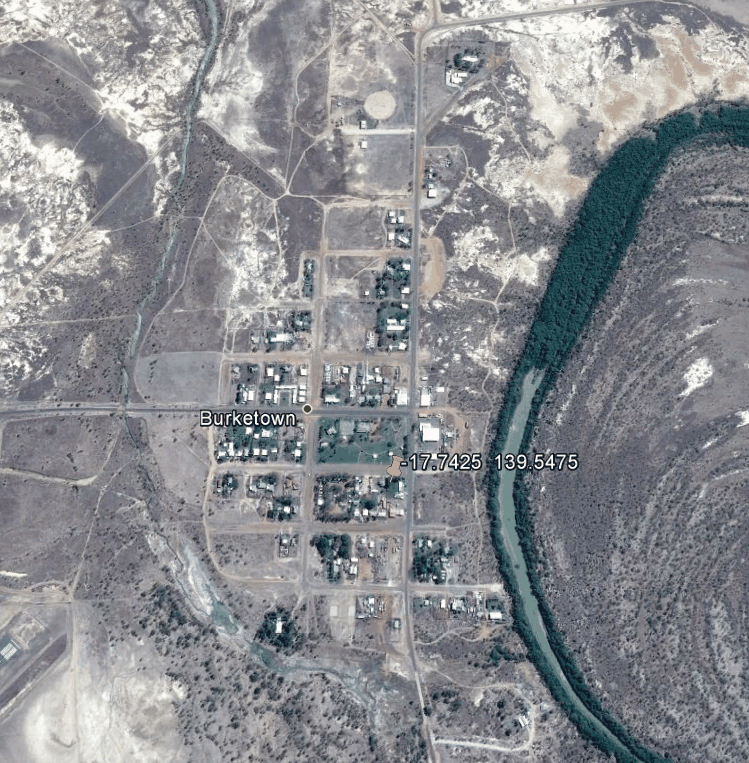
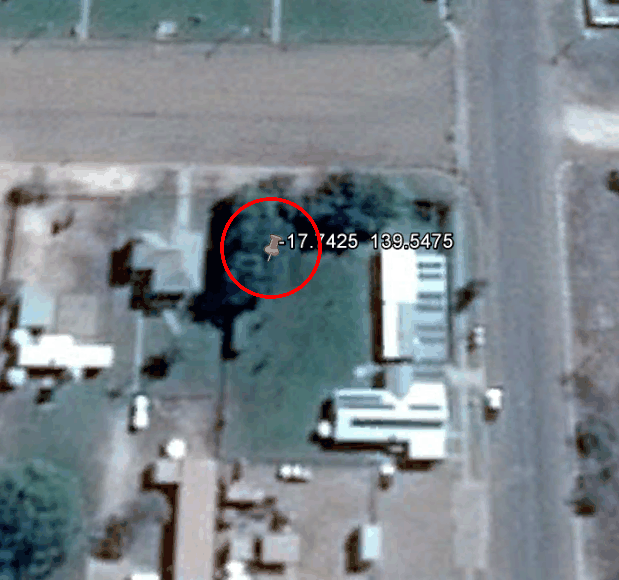
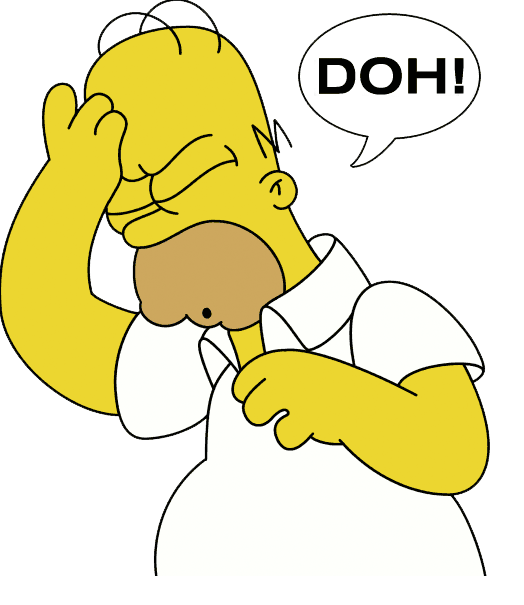

our BoM at work again..
and more on the fudging
http://www.thegwpf.com/under-pressure-australian-met-office-confirms-data-manipulation/
Jail time required LOL
Don’t I wish.
Where do these people get their training in science? I’d throw them out of any graduate program. Reminds me of a quote by Feynman from his “Cargo Cult” speech:
“But there is one feature I notice that is generally missing in cargo cult science. That is the idea that we all hope you have learned in studying science in school—we never say explicitly what this is, but just hope that you catch on by all the examples of scientific investigation. It is interesting, therefore, to bring it out now and speak of it explicitly. It’s a kind of scientific integrity, a principle of scientific thought that corresponds to a kind of utter honesty—a kind of leaning over backwards. For example, if you’re doing an experiment, you should report everything that you think might make it invalid—not only what you think is right about it: other causes that could possibly explain your results; and things you thought of that you’ve eliminated by some other experiment, and how they worked—to make sure the other fellow can tell they have been eliminated.”
“Details that could throw doubt on your interpretation must be given, if you know them. You must do the best you can—if you know anything at all wrong, or possibly wrong—to explain it. If you make a theory, for example, and advertise it, or put it out, then you must also put down all the facts that disagree with it, as well as those that agree with it.” http://calteches.library.caltech.edu/51/2/CargoCult.pdf
The bottom line of what Dr. Feynman is exhorting his audience to do is clear and represents the highest science standards. That is, a scientist effectively has a moral obligation to be as thorough, dispassionate, unbiased, and complete in performing and reporting his or her work as possible. Thus, such an approach and solid integrity in scientific investigation and reporting is absolute and crucial. No exceptions should ever occur. Note how Dr. Feynman specifies these points (my emphasis):
• “…a kind of utter honesty
• “…a kind of leaning over backwards
• “…you should report everything you think might make [your experiment] invalid
• “…details that could throw doubt on your interpretation must be given, if you know them
• “…put down all the facts that disagree with [your theory], as well as those that agree with it
• “You must do the best you can…”
Really.
+100
By that standard real scientists are few and far between because most people do not have the courage to be honest, and it does take courage. Most rather be ‘Team Players’
For an analysis of this issue at US weather stations, see here:
http://notrickszone.com/2014/08/20/analysis-of-23-top-qualty-us-surface-stations-shows-insignificant-warming-only-0-16c-rise-per-century/
The “greenhouse effect” should be renamed the “fishnet effect”. A fishnet prevents heat from escaping without affecting convection just like the addition of CO2 to an atmosphere. If the increase in CO2 of the last century has increased the amount of downwelling IR by 2% of ground emissions. A fishnet made with 1/8in.(3mm) threads would have holes a feet (30cm) apart in order to emit this amount of heat.
If people could see this fishnet, I think they would stop blaming short term weather events on CO2. And this includes the difference between night temperatures and day temperatures.
This actually has little to do with urbanization and/or pavement, buildings, etc., but more with tree growth.
The weather station seems to be located by a couple of trees, which very likely weren’t as tall or wide as they were several decades ago. The leaves on trees create a backscattering of OLR at night which will keep the areas under the trees and their immediate surroundings (about 5 meters) slightly warmer than areas outside of the tree cover. This effect is most apparent on a morning with frost where the temperatures remains above freezing. There will be frost on the open areas but under the trees sometimes won’t even have dew formation. This is due to the trees keeping the air temperatures 2-3°F warmer than their surroundings. So a siting issue is probably the cause of the rise in minimum temperatures but likely arising from tree cover and not asphalt.
Huh?
Asphalt has been used for storing solar energy in passive solar setups, precisely because it is known to absorb/hold heat and slowly radiate it back over a fairly long period of time…it’s a dense, dark colored material that is perfect for the job.
But you are saying that out in the open it’s the tree leaves that are causing backscattering to raise the temperature and NOT the heat-holding asphalt that practically surrounds the site in question?
Also, if the trees are deciduous, then wouldn’t the lack of leaves on frosty mornings invalidate the assumption that it is backscattering? Because, usually, when it is frosty deciduous trees DO NOT HAVE LEAVES!!!
No to mention trees make an area COOLER – transpiration… we learned it in grade school.
Or the shade they provide keeping the measuring device out of the direct sunlight…like an additional Stevenson screen.